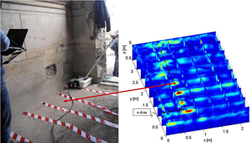
A non-destructive and minimally invasive characterization of non-directly accessible spatial regions is of huge interest in several applicative fields. Examples are:
- detection and monitoring of utilities;
- mapping of asphalt layers extent and status;
- remote investigation of planets’ soil in order to detect the presence of water;
- archeological prospection, to localize archeological sites and map their plant in order to properly address stratigraphic essays as well as acquire information on buried structures located in areas where direct inspection is not possible;
- forensic framework in order to localize corpses as well as weapons;
- mitigation of anthropic risk.
In all these applicative frameworks, the capability of microwaves to penetrate opaque media is exploited to acquire information on hidden targets from remote or in situ radar measurements. This is possible owing to active microwave imaging technologies, such as the ground penetrating radar or georadar.



